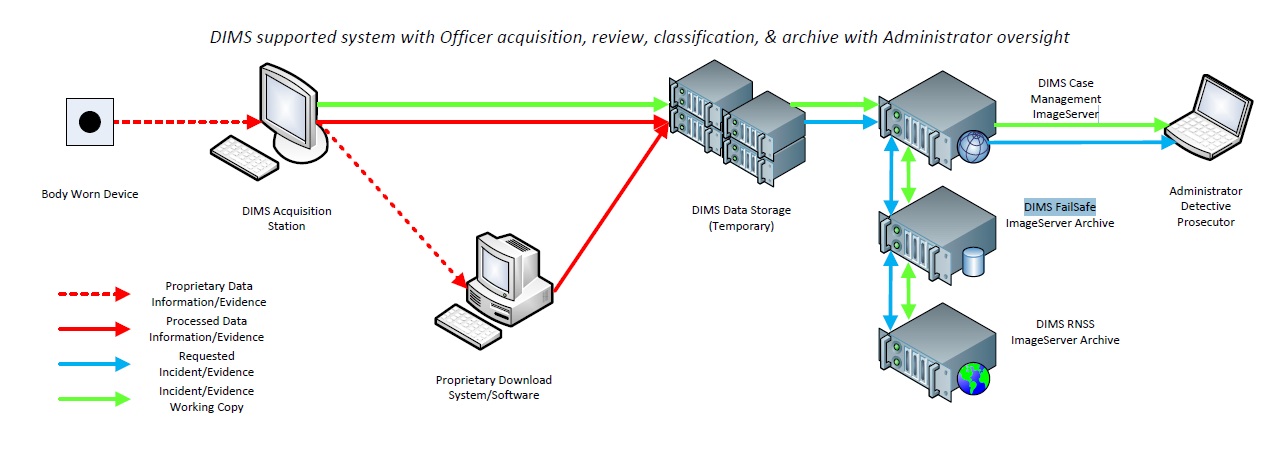A decision must be made as to the desired workflow for acquisition, classification, access control, dissemination, and deletion of the audio and video information and/or evidence generated from the body worn devices. There are several different workflow scenarios and processes to achieve the desired results for identifying and separating information obtained from field personnel in their everyday contacts with citizens from actual segments of that information that are deemed as evidentiary and/or have investigative value, training value, or that reduce liability for the City. The amount of assets that will require active management will be a very small subset of the total volume of assets collected on a daily basis.
The first workflow that is desirable for many Departments is similar to the data collection utilized in in-car video:
- This workflow involves all audio and video data collected is stored in the device then viewed and acquired when requested into an information
 and/or evidence management system for classification and chain-of-custody.
and/or evidence management system for classification and chain-of-custody. - A process, initiated by an Officer, starts and ends audio and video recording for each incident or contact and that data is stored locally in the device/unit. Typically, each video segment is identified by time, date, unit number, GPS location, and/or incident number.
- The audio and video is transferred/moved, either through a wireless connection or manually through a physical connection at the station, to a large storage solution for temporary storage. The data on the storage device no longer resides on the unit.
- This physical move of the data is accomplished utilizing the software and interface provided from the body worn manufacturer and may involve preliminary basic classification or tagging by the Officer.
- After the end of shift, an Officer potentially will request a specific piece of the video that is relevant to a specific incident. Alternately, an Administrator may request for review multiple segments of video for training purposes. Another trigger would be generated by a citizen request and/or complaint.
- Upon receipt of the request, an Administrator will locate the segment of video and audio from the storage solution then copy it to the information and/or evidence management system (DIMS). At this time, the Administrator will classify the information/evidence and the chain-of-custody and log tracking will commence.
- Audio and video data stored on the storage solution for in-car will be automatically purged (overwritten) at a specific time period.
- This workflow is a time intensive process for the Administrator but does not impact the Patrol Officer at end of shift.
An alternate workflow that is currently utilized by many Departments and is similar to data collection from Crime Scene, Patrol, Detective Units, and other information and/or evidence obtained from digital cameras, digital audio recorders, or other devices.
- This workflow involves acquisition and processing of information/evidence at or during the shift in which it is collected.
- Typically, the Officer, Detective, Crime Scene personnel, or others that have digital photographs, audio, and/or video will return to the station or sub-station and acquire their information by plugging in a card or attaching their device to a system that has access to their information and evidence repository (DIMS).
- An intermediary step may be required, utilizing the software and interface provided from the body worn manufacturer, if the device produces proprietary formats for data.
- The information/evidence is copied from the device to a local drive(s) and/or servers. The individual that was the originator of the data is responsible for reviewing and classifying the data at the time of downloading/acquisition, typically while writing reports.
- Log tracking and audit trail exists from the moment that the device or card is plugged into the acquire system and additionally, the information and/or evidence is immediately available to personnel that have the correct permission(s) to view the assets.
- This gives the originator the advantage of reviewing their own information/evidence for quality control, report writing, classification based on their direct involvement with the data.
- When they are finished, the data is removed from the camera card or temporary storage from the acquisition device.
- Based on the classification during acquisition, information that is not important and does not need to be retained, (based on retention policy), will be queued up for deletion and/or archive at a predetermined time set by the Administrator.
- This workflow eliminates the need for an Administrator to manually process information and/or evidence and has a minimal time impact on a Patrol Officer since they can acquire the information and/or evidence while writing reports.
- Some Agencies are moving toward a workflow that allows Patrol Officers to acquire information and/or evidence from digital cameras, audio recorders, or body worn devices directly from the MDCs in the Patrol Units in the field.
- This workflow is a time intensive process for the Officer but eliminates a significant amount of Administrative resources.

